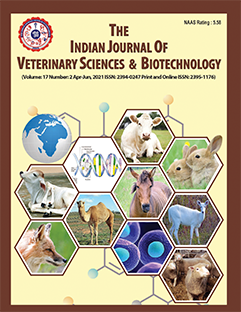In Silico Neuroproteomic Profiling of Chicken Brain Development Reveals Stage-Specific Molecular Signatures and Functional Pathways
DOI:
https://doi.org/10.48165/ijvsbt.21.6.16Keywords:
Chicken brain, Embryogenesis, Gallus gallus, In-silico proteomics, Neurodevelopment, Pathway analysis, Protein interactionAbstract
Brain development in vertebrates is a highly coordinated process involving the temporal and spatial expression of proteins that govern neural induction, patterning, differentiation, and maturation. In the chicken model, SDS-PAGE profiling across developmental stages - from embryonic day 0 to adulthood - has revealed stage-specific protein bands indicative of dynamic proteomic shifts. However, the functional identity and biological relevance of these proteins remain underexplored. In this study, we employed an in silico neuroproteomic approach to annotate and analyze these developmentally regulated proteins. Using tools such as BLAST, STRING, PANTHER, and DAVID, we mapped each protein to its respective biological processes, cellular components, and molecular functions. Key proteins such as FGF2, amyloid precursor protein (APP), myelin basic protein (MBP), and β-catenin exhibited distinct expression patterns correlating with critical neurodevelopmental events, including axoneogenesis, synaptogenesis, and myelination. Protein-protein interaction networks revealed hubs central to neural signaling, structural organization, and brain maturation. Pathway enrichment analysis further highlighted involvement in Wnt signaling, neurotrophin signaling, and myelin sheath formation. This integrative analysis provides a systems-level view of chicken brain development, underscoring conserved and stage-specific molecular pathways. Our findings offer valuable insights for neurobiology and open new avenues for translational research in poultry production.
Downloads
References
Carulli, D., Pizzorusso, T., Kwok, J.C., Putignano, E., Poli, A., Forostyak, S., Andrews, M.R., Deepa, S.S., Glant, T.T., & Fawcett, J.W. (2010). Animals show early formation of perineuronal nets in the chicken brain: Postnatal development and expression patterns. Brain, 133(8), 2331–2347.
Frischknecht, R., & Seidenbecher, C. (2012). Brevican: A key proteoglycan in the perisynaptic extracellular matrix of the brain. International Journal of Biochemistry & Cell Biology, 44(7), 1051–1054.
Gasteiger, E., Hoogland, C., Gattiker, A., Duvaud, S., Wilkins, M.R., Appel, R.D., & Bairoch, A. (2005). Protein identification and analysis tools on the ExPASy server. In J.M. Walker (Ed.), The Proteomics Protocols Handbook (pp. 571–607). Humana Press.
Ghanem, K., & Johnson, A.L. (2021). Quantitative proteomic analysis of chicken serum reveals key proteins affecting follicle development during reproductive phase transitions. BMC Genomics, 22, 11180.
Huang, D.W., Sherman, B.T., & Lempicki, R.A. (2009). Bioinformatics enrichment tools: Paths toward the comprehensive functional analysis of large gene lists. Nucleic Acids Research, 37(1), 1–13.
Lu, H., Zhang, X., & Wang, J. (2024). Single-cell technologies and multi-omics integration in livestock and poultry. International Journal of Molecular Sciences, 25(23), 12940.
McGowan, L.D., Alaama, R.A., & Striedter, G.F. (2013). FGF2 delays tectal neurogenesis, increases tectal cell numbers, and alters lamination in embryonic chicks. PLoS One, 8(11), e79949.
Mi, H., Muruganujan, A., & Thomas, P.D. (2013). Large-scale gene function analysis with the PANTHER classification system. Nucleic Acids Research, 41(Database Issue), D377–D386.
Peng, M., Li, H., He, L., & Ma, H. (2018). Proteomics reveals changes in hepatic proteins during chicken embryonic development. BMC Genomics, 19, 29.
Saadeldin, I.M., Tanga, B.M., Bang, S., Seo, C., Maigoro, A.Y., Kang, H., … & Cho, J. (2023). Isolation, characterization, proteome, miRNAome, and the embryotrophic effects of chicken egg yolk nanovesicles (vitellovesicles). Scientific Reports, 13, 4204.
Stadlmann, J., Hudecz, O., Krssakova, G., & Mechtler, K. (2024). Deep proteome of the developing chick midbrain. Journal of Proteome Research. Advance online publication.
Swaroop, M.N., & Barati, A. (2012). Differential expression of chicken brain proteins during development. International Journal of Pharmaceutical and Biological Sciences, 3(4), 1129–1136.
Szklarczyk, D., Gable, A.L., Lyon, D., Junge, A., Wyder, S., Huerta-Cepas, J., … & von Mering, C. (2019). STRING v11: Protein–protein association networks with increased coverage, supporting functional discovery in genome-wide experimental datasets. Nucleic Acids Research, 47(D1), D607–D613.
Urgessa, S.H., Kim, D.H., & Kim, K.W. (2023). OMICs approaches and technologies for understanding feed efficiency in chickens. Animal Biotechnology. Advance online publication.
Voukali, E., Veetil, N.K., Němec, P., Stopka, P., & Vinkler, M. (2021). Comparison of plasma and cerebrospinal fluid proteomes identifies gene products guiding adult neurogenesis and neural differentiation in birds. Scientific Reports, 11, 5312.
Wadood, S.F., & Zhang, X.Q. (2024). The omics revolution in understanding chicken reproduction: A comprehensive review. Current Issues in Molecular Biology, 46(1), 295–309.
Downloads
Published
Issue
Section
License
Copyright (c) 2025 Indian Journal of Veterinary Sciences and Biotechnology

This work is licensed under a Creative Commons Attribution-NonCommercial-NoDerivatives 4.0 International License.




